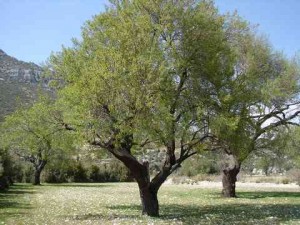Dormant spray for almond trees
 Question from Dan:
Question from Dan:
I’m sorry, please consider this an addendum to the previous contact I just now sent you. In my excitement to read your responses I forgot question number six. The property I now own has two almond trees that quite possibly are over 50 years old. They are also producing almonds but not to the potential they have because they are neglected and diseased. I realize that I have to do some pruning this coming winter and also know I need to treat them for the infestation of termites and other critters that occupy the insides of the tree. Chris at Cherry Valley Nursery in Cherry Valley has told me to see him in November for a potion blended of copper and petroleum that he wants me to spray on the trees after they have been pruned of all the dead branches. Does this sound like a process you would do? I am MOST interested in maintaining a natural and organic setting in this instance.
Answer from Pat:
When fall rolls around and your almond trees have dropped leaves, prune off any dead or damaged wood. Follow up by pruning lightly according the recommendations for pruning almonds in a good pruning manual. Since these trees are old and have not been pruned in years, don’t overdo the pruning this time around or you could stimulate a lot of bushy growth at the expense of flowers and nuts.
After pruning, even as an organic gardener it is wise to apply dormant spray. (Dormant spraying is a practice followed by organic gardeners as well as conventional gardeners and when done correctly it can stop pests and diseases in winter when there are no flowers, leaves, or fruit on the tree.) However, several years after creating an all-organic garden, you may not need to apply dormant spray any more, except for peach trees. (Peach leaf curl is difficult or impossible to control any other way.) The reason some gardeners do not use dormant spray is because they feel their plants are being protected from fungus diseases by beneficial fungi that have built up in the soil. Oils, however, in my opinion could always help since they coat the bodies of over-wintering pests and thus suffocate kill them by suffocation.
Dormant spray is a combination of fungicide, such as fixed copper-sulfate spray or Bordeaux (lime-sulfur) spray with Volk Horticultural Oil or with a lighter horticultural oil such as Bonide’s “All Season Spray Oil”. As of this year, ready-made Bordeaux (lime sulfur) spray is no longer sold in California. (I used to recommend a product called Bonide’s Organic Lime-Sulfur fruit tree spray that apparently now will no longer be on the market.) You can make your own Bordeaux spray, but most gardeners do not want to do that. If I were you I would wait until fall to decide what to use, since new organic products are continually being brought onto the market. There maybe a new organic fungicide for dormant spray use. Otherwise use a mixture of fixed copper-sulfate with horticultural oil after pruning and use it two or three times a month apart during the winter and before buds swell. This will kill many over-wintering pests as well as any spores of fungus. Try not to get too much onto the ground. (Spraying all over the trunk and branches with the sprayer up close is the way to go instead of spraying all over like a rain shower or a blanket spray.) By not getting too much on the ground you can prevent any build-up of copper in the soil. Also, be sure to wear protective goggles, hat, gloves and clothing while spraying. After spraying, wash the clothing before using it again. I can’t do this job any more but back in the days when I did this job years ago I reached all parts of the tree by using a 3-legged orchard ladder which I still have.

